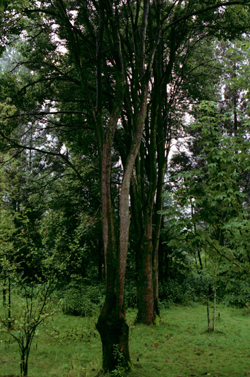Harvesting Trees to Make Ecstasy Drug
(Page 2 of 3)
The current production methods of safrole-rich oils endanger both the flora and fauna in fragile ecosystems and impact on the livelihood of the local population. To produce the oil, entire wild and often rare forest trees are felled and the oil is steam-distilled from the timber, the root and stump. The wood is chopped into small blocks and shredded. This is then distilled in large metal vats over wood fires for at least five days. The firewood needed to steam-distill the oil exacerbates the harm.
According to TNI research in northern Burma, for every safrole-rich tree, ten other trees are needed to distil the oil.
A survey in East and Southeast Asia by the UNODC in 2006 found 361 plants that are rich in safrole, mostly of the cinnamon tree species, such as the camphor tree (Cinnamomum camphora)—a large evergreen tree up to 20-30 meters tall common in Southeast Asia.
A More Common Sense Approach
In most species, safrole is in the root and the stumps. Nevertheless, some plant species make it possible to extract the oils from leaves and twigs and can thus be harvested in a sustainable manner.
In China and Brazil, experiments with new, sustainable plants and trees are well advanced—in particular some Cinnamomum species and the Pimenta longa (Piper hispidinervium), which has been introduced to Yunnan from Brazil, by the Xishuangbanna Tropical Botanical Garden in China's Yunnan Province.
Although the worry about the ecological damage is justifiable, questions remain about the effectiveness of public burnings. The approach might backfire by driving up the price and attracting more illegal harvesters.
It is also questionable whether all the oil was destined for ecstasy laboratories since the bulk of the oil is still used for legal purposes. A wiser approach might be to sell the seized oil to the chemical industry and use the proceeds to set up sustainable production of safrole oil, providing livelihoods for the people involved.
Safrole-rich Oil in Burma
Burma produces more safrole-rich oil than Cambodia, according to a survey in East and Southeast Asia by the UNODC in 2006. The aggregate annual production of safrole-rich oil in the region is estimated at 1,500 tons. China produces about 800 tons, Burma 230-490 tons, Cambodia 250 tons, Laos 45 tons and Indonesia 35 tons. The Chinese chemical industry is the major end-user of the oils.
 |
| Safrole-rich oil tree (Photo: TNI) |
All countries in the region have regulations to control the harvesting and production of safrole-rich oils, including export and import. In Cambodia, Laos and Burma, these measures apply to all non-timber forest products; only China and Vietnam have specific legislation.
The increased control in China and Vietnam, the two major trading countries, seems to have shifted production to countries were controls are less strict and law enforcement capacity is low, such as Burma, Laos and Cambodia. The National Narcotics Control Commission (NNCC) of China for instance reported the import of large quantities of safrole-rich oil from Burma in 2004-2006.
Permits were issued by the Burmese authorities to companies to harvest wood for oil production at the Tamanthi Hydropower Project in the Chindwin River in Sagaing Division near the border with India, where a dam would eventually cause submersion of large tracks of land the area.
Five companies were licensed and each operated about 50 small stills to produce 340 tonnes of thitkado oil for export to China. Illegal production of the oils and export to China also occurred; 115 tons were seized during 2002-2005 along smuggling routes from Sagaing Division to Yunnan.
TNI research in 2008 found that thitkado oil is produced and traded in Kachin State. According to a Burmese government official, safrole-rich oils are produced in the country, but production is declining. He mentioned that trees in Kachin State were depleted. Since 1998, the main production area was the Nhkai Bum Mountains, but this area is nearly completely deforested.
« previous 1 | 2 | 3 next page »
- 'My Wife Died From Police Abuse,' Says Husband
- US Says Observer Conditions Don't Meet Int'l Standards
- 159 Observers to Monitor Burma Election
- Govt to Address Breaches of SSA-South Ceasefire: Aung Min
- Burma Investors Pin Hopes on Seminal Sunday
- Malaysia PM Leads 50-Strong Delegation to Burma
- US Congress to Assess Burma's Political Prisoner Issue
- Rangoon Woman in Police Station Death Plunge
- Burmese Legal System Remains Tool of Govt: AHRC
- Burmese Army Chief Defends Political Role
